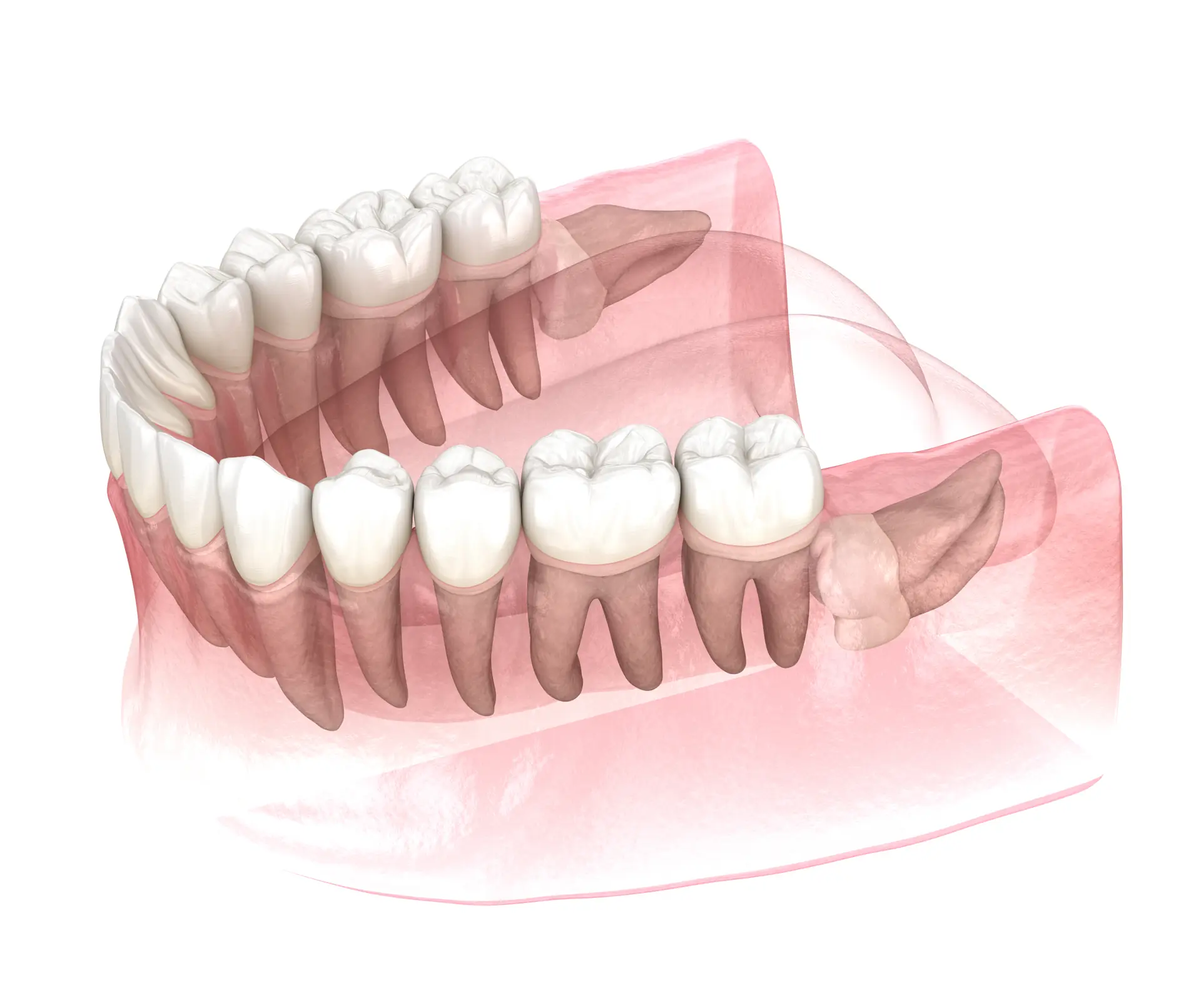Crowded teeth are a common dental problem that affects both children and adults. In fact, it is estimated that 50% of the population has some form of teeth crowding. Despite its prevalence, many people still don’t fully understand what teeth crowding is, how it can impact their oral health, and the options for crowded teeth available to them.
What is Teeth Crowding?
Teeth crowding, also known as malocclusion or overcrowding, occurs when there is not enough space in the mouth for all of your teeth to fit properly. This can result in teeth that are crooked, rotated, or overlapping.
In some cases, it may even cause your teeth to become impacted, meaning they are unable to fully emerge from the gums. Teeth crowding is most commonly found in the lower front teeth and can also occur in the upper front teeth, affecting the overall dental arch.
Causes of Teeth Crowding
There are several factors that can contribute to teeth crowding. Some of the most common causes include:
- Genetics: Did you know that your genetics play a huge role in determining the size and shape of your jaw? And it doesn’t stop there – the size of your teeth is also influenced by your genes. If you have inherited small jaws or large teeth from your parents, you may be more prone to developing crowded teeth.
- Childhood habits: Habits such as thumb sucking, pacifier use, and tongue thrusting can all impact the development of your teeth and jaw. These habits can create pressure on the teeth, causing them to become crowded or misaligned.
- Lack of early orthodontic intervention: If misalignment issues are not addressed in childhood, it can lead to more severe crowding later on in life. This is because the teeth have already settled into a crowded position and may not have enough available space to shift back into the correct position.
- Teeth extractions: In some cases, teeth crowding can be caused by previous tooth extractions. This is because removing one or more teeth can create extra space in the mouth, causing the remaining teeth to shift and become crowded.
Depending on the cause of your teeth crowding, the severity can vary. Some people may only have slight crowding, while others may experience more severe cases that require orthodontic treatment.
Effects of Teeth Crowding
Teeth crowding can have a number of negative effects on your oral health, appearance, and overall well-being. Some common consequences of teeth crowding include:
- Difficulty maintaining oral hygiene: Having crowded teeth can make it challenging to thoroughly clean and floss between each tooth. This buildup of plaque and bacteria can heighten the chances of gum disease, tooth decay, and unpleasant breath.
- Misaligned bite: Crooked teeth can result in an irregular bite, where the upper and lower teeth don’t align correctly. This can cause problems with chewing and may lead to jaw pain or discomfort due to the limited available space.
- Increased risk of dental issues: When teeth are crowded, they can create tight spaces that make it difficult for saliva to reach and neutralize harmful bacteria, thus increasing the chances of cavities, gum disease, and other dental issues.
- Negative impact on self-esteem: Crowded teeth can also affect your self-esteem and confidence in a negative way. Many people feel self-conscious about their appearance when their teeth are crowded or misaligned, leading to feelings of insecurity and low self-worth.
- Speech difficulties: In some cases, teeth crowding can also affect speech patterns and cause difficulty with pronunciation. This is especially common when the front teeth are crowded or overlapping.
Different cases of teeth crowding may have varying degrees of severity and effects, but it is important to address the causes of crowded teeth in order to maintain good oral health and confidence.
Frequently Asked Questions About Teeth Crowding
What causes teeth crowding?
There are several potential causes of teeth crowding, including genetics, childhood habits, and dental issues. Some people may be genetically predisposed to have smaller jawbones or larger teeth, which can lead to overcrowding and affect the alignment of their permanent teeth.
Extended thumb sucking or prolonged pacifier use during childhood can impact the growth and development of teeth, leading to dental crowding. Additionally, dental issues such as missing teeth or impacted wisdom teeth can contribute to teeth overcrowding.
Can braces fix crowded teeth?
Yes, braces are one of the most common treatments for crowded teeth. Braces gradually move the teeth into their proper positions over a period of time, creating more space in the mouth and correcting any misalignment. In some cases, tooth extraction may also be necessary to create enough space for the teeth to properly align.
Is it possible to prevent teeth crowding?
While genetics and childhood habits cannot be controlled, there are certain preventative measures that can help reduce the risk of developing crowded teeth. These include practicing good oral hygiene, avoiding prolonged use of a pacifier or thumb sucking, and addressing any dental issues such as missing teeth or impacted wisdom teeth early on.
Are there any health risks associated with crowded teeth?
Teeth crowding can lead to several potential health risks if left untreated. These include an increased risk of tooth decay and gum disease due to difficulty cleaning between tightly packed teeth, which can affect permanent teeth. Crowded teeth can also cause speech difficulties and can put unnecessary pressure on the jaw, leading to jaw pain and headaches.
What are the treatment options for teeth crowding?
Aside from braces, there are other treatment options available for crowded teeth. Invisalign has become a well-liked option for those seeking an alternative to braces. It utilizes clear aligners that are nearly undetectable, making it an attractive choice. This option may be more appealing to those who want a more discreet treatment method. In some cases, a retainer may also be used to prevent further crowding after braces or Invisalign treatment, ensuring that the teeth maintain their new positions within the dental arch.
How long does it take for braces to fix crowded teeth?
The duration of braces treatment varies depending on the severity of the crowding and the individual’s response to the treatment. On average, braces are worn for approximately 1-3 years. However, it is important to follow the orthodontist’s instructions and attend regular appointments for optimal results.
Can adults get braces for crowded teeth?
Absolutely! While braces are commonly associated with teenagers, they can also be an effective treatment option for adults with crowded teeth. In fact, according to the American Association of Orthodontists, about 20% of orthodontic patients are adults. It’s never too late to improve the alignment and health of your teeth.
Teeth crowding is a common dental issue that can have negative impacts on both oral health and self-confidence. It is important to seek treatment for crowded teeth, not only for aesthetic reasons but also for overall oral health.
With various treatment options available, there is no need to suffer from the discomfort and embarrassment of crowded teeth. Together with your orthodontist, you can achieve a straighter, healthier smile by exploring various options for crowded teeth.
Customized Treatment Plans At River District!
At River District Smiles Dentistry, our approach to addressing teeth crowding is all about customization. We understand that each patient is unique, with specific dental needs, lifestyle considerations, and aesthetic preferences. That’s why we design personalized treatment plans tailored to your individual requirements.
Our experienced dental professionals take into account factors such as your oral health status, the severity of your teeth crowding, and your desired smile goals. Whether you go with the more conventional metal braces or the less noticeable clear aligners, we ensure that your treatment plan aligns with your specific needs and aspirations.
Our commitment to customization ensures that you receive the most effective and personalized care to achieve the straight, healthy smile you desire. We believe that your dental journey should be as unique as you are, and our tailored treatment plans reflect this commitment.



